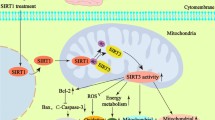Abstract
Somatostatin which is a multifunctional growth hormone inhibitory neuropeptide shows diverse physiological effects, such as neurotransmission, cell growth, apoptosis, and endocrine signaling as well as exerts inhibitory effects on hormonal products and other secretory proteins. SSTR3 is a member of superfamily of somatostatin receptors (SSTR), which are G-protein-coupled plasma membrane receptors. Previous studies proved that SSTR3 regulates antiproliferative signaling and apoptosis in several cells. Here, we explored a potential role of SSTR3 in the regulation of neuronal apoptosis in the course of intracerebral hemorrhage (ICH). An ICH rat model was established and assessed by behavioral tests. We found SSTR3 was significantly upregulated surrounding the hematoma after ICH by Western blot and immunohistochemistry. Double immunofluorescence-manifested SSTR3 was strikingly increased in neurons, not astrocytes or microglia. Moreover, increasing SSTR3 level was found to be accompanied by the upregulation of p53, Bax, and active caspase-3 in vivo and in vitro studies. Furthermore, we detected that neuronal apoptosis marker active caspase-3 was co-localized with SSTR3 suggesting its potential role in neuronal apoptosis. In addition, in vitro study, revealed that SSTR3 knockdown specifically resulted in reducing neuronal apoptosis in PC12 cells, which further indicated that SSTR3 might exert its pro-apoptotic function on neuronal apoptosis. All our findings suggested that upregulated SSTR3 may be involved in neuronal apoptosis after ICH.







Similar content being viewed by others
References
Aronowski J, Zhao X (2011) Molecular pathophysiology of cerebral hemorrhage: secondary brain injury. Stroke 42(6):1781–1786
Bradl M, Lassmann H (2010) Oligodendrocytes: biology and pathology. Acta Neuropathol 119(1):37–53
Culmsee C, Mattson MP (2005) p53 in neuronal apoptosis. Biochem Biophys Res Commun 331(3):761–777
Dragovich T, Rudin CM, Thompson CB (1998) Signal transduction pathways that regulate cell survival and cell death. Oncogene 17(25):3207–3213
Elmore S (2007) Apoptosis: a review of programmed cell death. Toxicol Pathol 35(4):495–516
Flaherty ML, Haverbusch M, Sekar P, Kissela B, Kleindorfer D, Moomaw CJ, Sauerbeck L, Schneider A, Broderick JP, Woo D (2006) Long-term mortality after intracerebral hemorrhage. Neurology 66(8):1182–1186
Hammond MD, Taylor RA, Mullen MT, Ai Y, Aguila HL, Mack M, Kasner SE, McCullough LD, Sansing LH (2014) CCR2 + Ly6C(hi) inflammatory monocyte recruitment exacerbates acute disability following intracerebral hemorrhage. J Neurosci 34(11):3901–3909
Hua Y, Schallert T, Keep RF, Wu J, Hoff JT, Xi G (2002) Behavioral tests after intracerebral hemorrhage in the rat. Stroke 33(10):2478–2484
Karabiyikoglu M, Hua Y, Keep RF, Ennis SR, Xi G (2004) Intracerebral hirudin injection attenuates ischemic damage and neurologic deficits without altering local cerebral blood flow. J Cereb Blood Flow Metab 24(2):159–166
Karwacki Z, Kowianski P, Dziewatkowski J, Domaradzka-Pytel B, Ludkiewcz B, Wojcik S, Narkiewicz O, Morys J (2005) Apoptosis in the course of experimental intracerebral haemorrhage in the rat. Folia Morphol 64(4):248–252
Kumar U (2005) Expression of somatostatin receptor subtypes (SSTR1-5) in Alzheimer’s disease brain: an immunohistochemical analysis. Neuroscience 134(2):525–538
Liew HK, Pang CY, Hsu CW, Wang MJ, Li TY, Peng HF, Kuo JS, Wang JY (2012) Systemic administration of urocortin after intracerebral hemorrhage reduces neurological deficits and neuroinflammation in rats. J Neuroinflamm 9:13
Liu X, Zhu XZ (1999) Roles of p53, c-Myc, Bcl-2, Bax and caspases in serum deprivation-induced neuronal apoptosis: a possible neuroprotective mechanism of basic fibroblast growth factor. NeuroReport 10(14):3087–3091
Martinou JC, Youle RJ (2011) Mitochondria in apoptosis: Bcl-2 family members and mitochondrial dynamics. Dev Cell 21(1):92–101
Patel YC (1999) Somatostatin and its receptor family. Front Neuroendocrinol 20(3):157–198
Qiu CZ, Wang C, Huang ZX, Zhu SZ, Wu YY, Qiu JL (2006) Relationship between somatostatin receptor subtype expression and clinicopathology, Ki-67, Bcl-2 and p53 in colorectal cancer. World J Gastroenterol 12(13):2011–2015
Sharma K, Patel YC, Srikant CB (1996) Subtype-selective induction of wild-type p53 and apoptosis, but not cell cycle arrest, by human somatostatin receptor 3. Mol Endocrinol 10(12):1688–1696
Stanic D, Malmgren H, He H, Scott L, Aperia A, Hokfelt T (2009) Developmental changes in frequency of the ciliary somatostatin receptor 3 protein. Brain Res 1249:101–112
Teijeiro R, Rios R, Costoya JA, Castro R, Bello JL, Devesa J, Arce VM (2002) Activation of human somatostatin receptor 2 promotes apoptosis through a mechanism that is independent from induction of p53. Cell Physiol Biochem 12(1):31–38
Wagener FA, Eggert A, Boerman OC, Oyen WJ, Verhofstad A, Abraham NG, Adema G, van Kooyk Y, de Witte T, Figdor CG (2001) Heme is a potent inducer of inflammation in mice and is counteracted by heme oxygenase. Blood 98(6):1802–1811
Williams RW, Rakic P (1988) Three-dimensional counting: an accurate and direct method to estimate numbers of cells in sectioned material. J Comp Neurol 278(3):344–352
Xi G, Keep RF, Hoff JT (2006) Mechanisms of brain injury after intracerebral haemorrhage. Lancet Neurol 5(1):53–63
Yuan D, Shen J, Yan Y, Wu X, Li A, Guo A, Wu Y, Duan C, Shen J, Tang C, Zhang D, Ji Y (2014) Upregulated expression of SSTR1 is involved in neuronal apoptosis and is coupled to the reduction of bcl-2 following intracerebral hemorrhage in adult rats. Cell Mol Neurobiol 34(7):951–961
Acknowledgements
This work was Funded by innovation and demonstration projects of Nantong Social Science and Technology (HS2011024). This work was also funded by the Youth Fund of the National Natural Science Foundation of China (81401013).
Author information
Authors and Affiliations
Corresponding authors
Ethics declarations
Conflict of interest
No potential conflicts of interest were disclosed.
Additional information
Qi Yao and Qianqian Liu have contributed equally to this work.
Rights and permissions
About this article
Cite this article
Yao, Q., Liu, Q., Xu, H. et al. Upregulated Expression of SSTR3 is Involved in Neuronal Apoptosis After Intracerebral Hemorrhage in Adult Rats. Cell Mol Neurobiol 37, 1407–1416 (2017). https://doi.org/10.1007/s10571-017-0471-7
Received:
Accepted:
Published:
Issue Date:
DOI: https://doi.org/10.1007/s10571-017-0471-7




